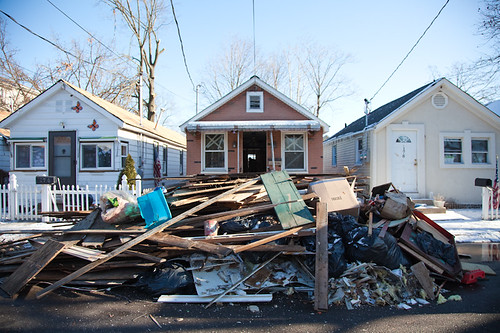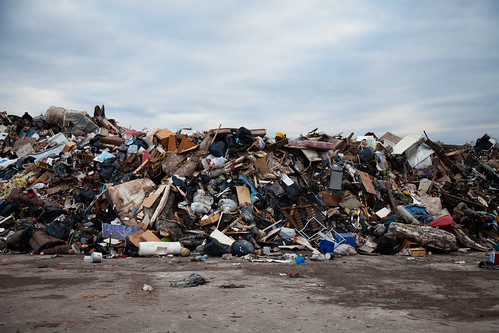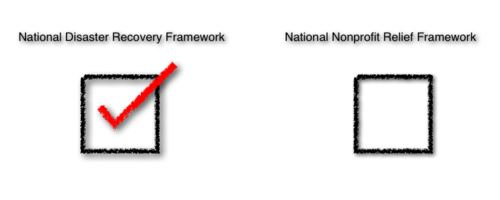Have you ever seen a competition cooking show where each chef had to prepare a meal based on the same ingredients? The results are always diverse, utilizing different ingredients in ways unique to each Chef's background and training. While there isn't a TV showcasing the development taking place, we are experiencing something similar in disaster response, a renaissance if you will of application creation aimed at increasing efficiencies of response organizations active in disaster response and recovery.
This list represents a small fraction of the applications/companies with applications that have been created in response to the growing number of disasters and their impacts on communities. This list does not include the wealth of googledoc spreadsheets, excel files, or access databases that are created ad hoc to deal with the onslaught of information needing attention following an event.
Crisis Cleanup
GRT Mobile Solutions
Project SGE 2.0
Palantir
Jointly.us
CERTify (an app for CERT Team coordination)
ArcGIS
WebEOC
Help Me Help
GeoOp (used by the SVA after the Christchurch Earthquakes)
HelpBridge
Crisis mappers
Ushahidi
Google Crisis Maps
Needmapper
Ready QLD (Queensland, Australia's app)
Recovers.org
While the creation of tools to help communities work with the myriad of groups that aid in response and recovery is great, and certainly welcomed, there is a growing concern that we're progressing too fast and not approaching this in a thoughtful or strategic manner. Just because you can go to an all you can eat buffet doesn't mean that you have to eat until you vomit right? Well the same idea applies--just because we can create an unlimited number of apps that marry GIS,workflow, and damage assessment data, doesn't mean we should...without first putting some parameters around what it is we're trying to accomplish and how these tools can help advance an overall plan. As it stands it feels like each response organization is using and in some cases pushing a unique application which can lead to competition for the one app to rule them all.
We're Not Speaking the Same Language
A consistent issue brought up after events is the lack of access to real-time information, data that can be used to help inform the decision making process during response and recovery. Due to privacy issues, organizations on the ground are reluctant to share information with one another or anyone else for that matter until after they've left. This is a problem, but it doesn't encompass the whole problem. Even if groups were better about sharing information, it couldn't be done easily because the applications that are currently being used don't "speak the same language." There are multiple apps doing the same thing but because of the way they've been built, they can't share info, and given that collaboration and cooperation are the cornerstones of successful response--this inability to share is becoming a problem. Everyone is pushing for faster and more efficient, which is great, but rare is the instance where all responding groups are using the same technological platform to work from so those gains in efficiency are marred when trying to work together.
It's understood that timely information is key to promoting a coordinated response effort, what isn't understood is what information we're talking about. I believe that the wealth of apps created to help communities is great, I just want to ensure that all of the apps created can "talk" to one another so that information can be shared in real time...that way, an established response organization and spontaneous groups are working with the same data sets. Experience tells me that no platform is going to be used 100% of the time by 100% of the groups active in response, if we know that then we should be working to provide a framework so that whatever applications are being used can easily interface with everything else out there to aid in response activities.
Disaster Data-Standard
In essence what I'm talking about is the creation of a disaster data standard. Core data sets that can be the foundational elements of any application mobile or otherwise, think of it like a disaster
API. If the foundation upon which all the apps are built is the same, then communication and the sharing of info should no longer be an issue. It turns out that I'm not the only on who's been thinking this way,
Nethope, a tech focused nonprofit has spearheaded something called the
Open Humanitarian Initiative, a broad-ranging effort with the goal of creating a unified data set that will aid in the delivery of disaster response in the information age. This presentation gives you a more detailed view of what their aim is:
Open Humanitarian Initiative - 2013 Plan from
Gisli Olafsson
Technology is a tool, not a solution
In the midst of the conversation on the mass proliferation of technology and how it can impact disaster response, it's important to remember that technology is only as powerful as those who wield it, and that during times of crisis people tend to go with what's easiest and most comfortable. While the agencies responding may be well versed in the latest and greatest, if all disasters begin and end at the local level, it's important that those who will be there long after the National groups have left are comfortable with whatever system has been left for them, if they're not, a new system will be cobbled together and people will start over.
Access to reliably accurate and timely information is essential to gaining situational awareness following a disaster. When every responding organization holds a different piece of the puzzle to gaining situational awareness, efforts are hampered and gaining unity of effort becomes exceedingly difficult. But don't take my word for it, the former Minister of Science and Technology of South Africa said it much better in 2005 at the
Southern African Telecommunications Networks and Applications Conference :
“The tsunami that devastated South Eastern Asian countries and the north-eastern parts of Africa, is perhaps the most graphic, albeit unfortunate, demonstration of the need for global collaboration, and open ICT* standards. The incalculable loss of life and damage to property was exacerbated by the fact that responding agencies and non-governmental groups were unable to share information vital to the rescue effort. Each was using different data and document formats. Relief was slowed, and coordination complicated.”
*Information and Communications Technology



















